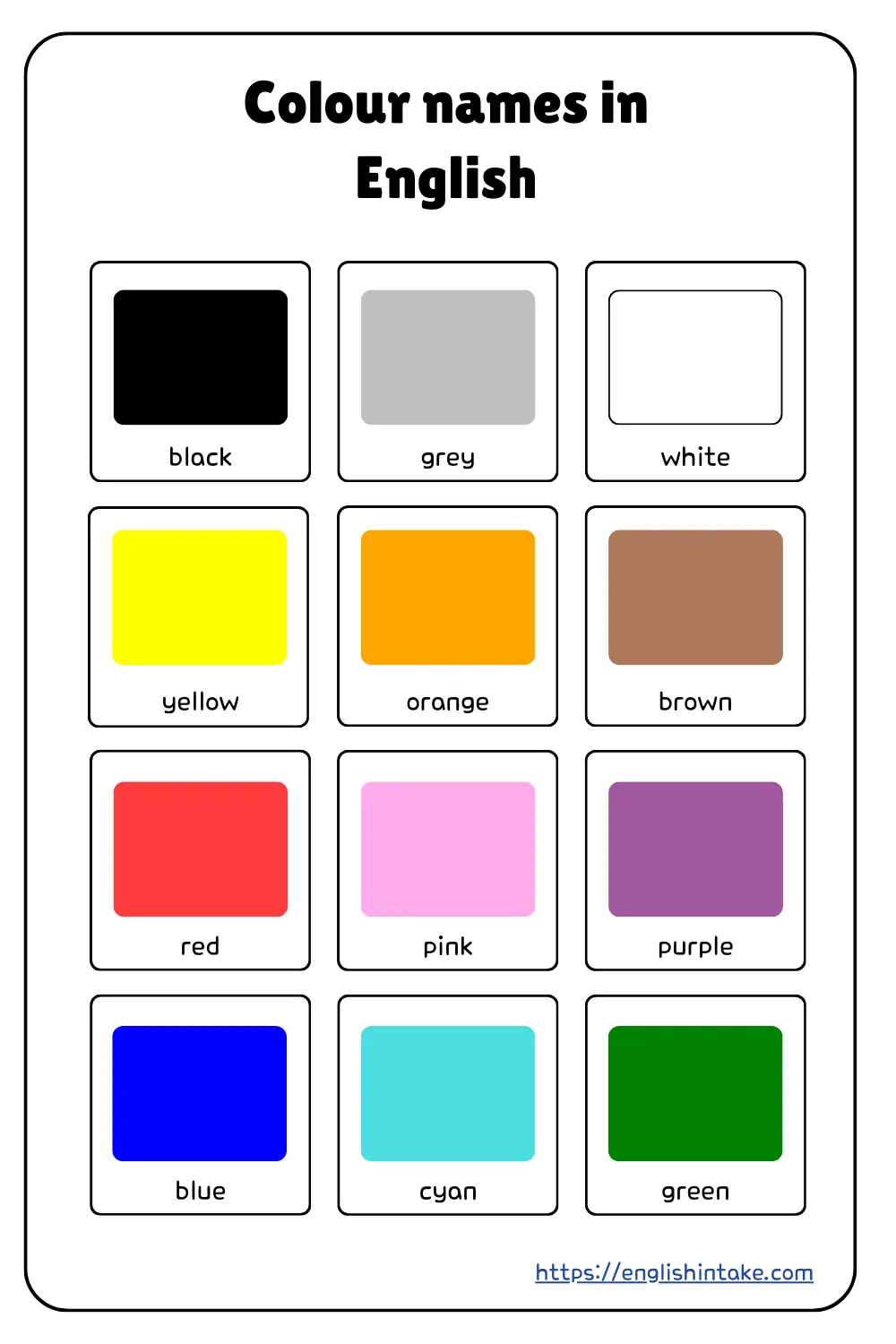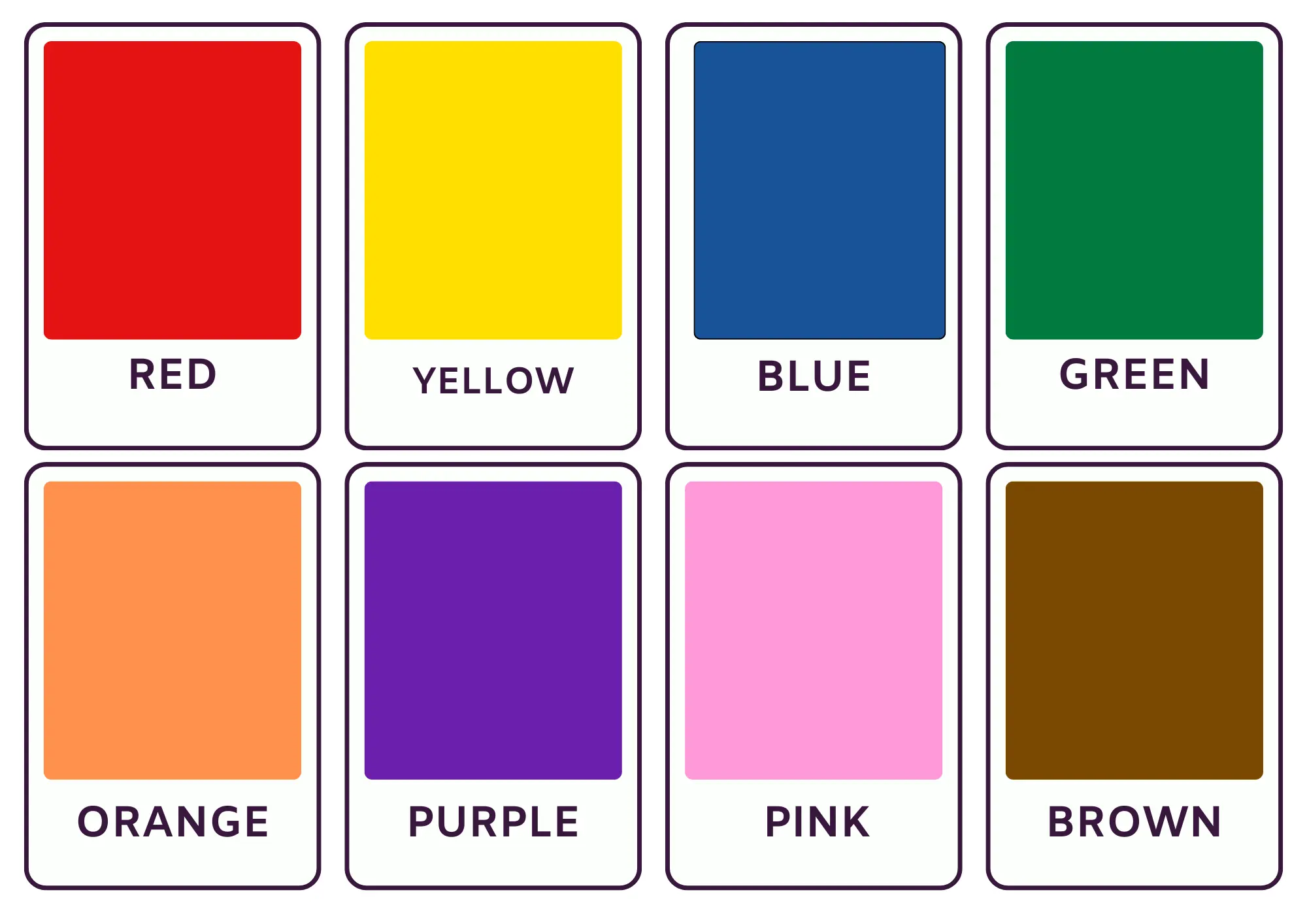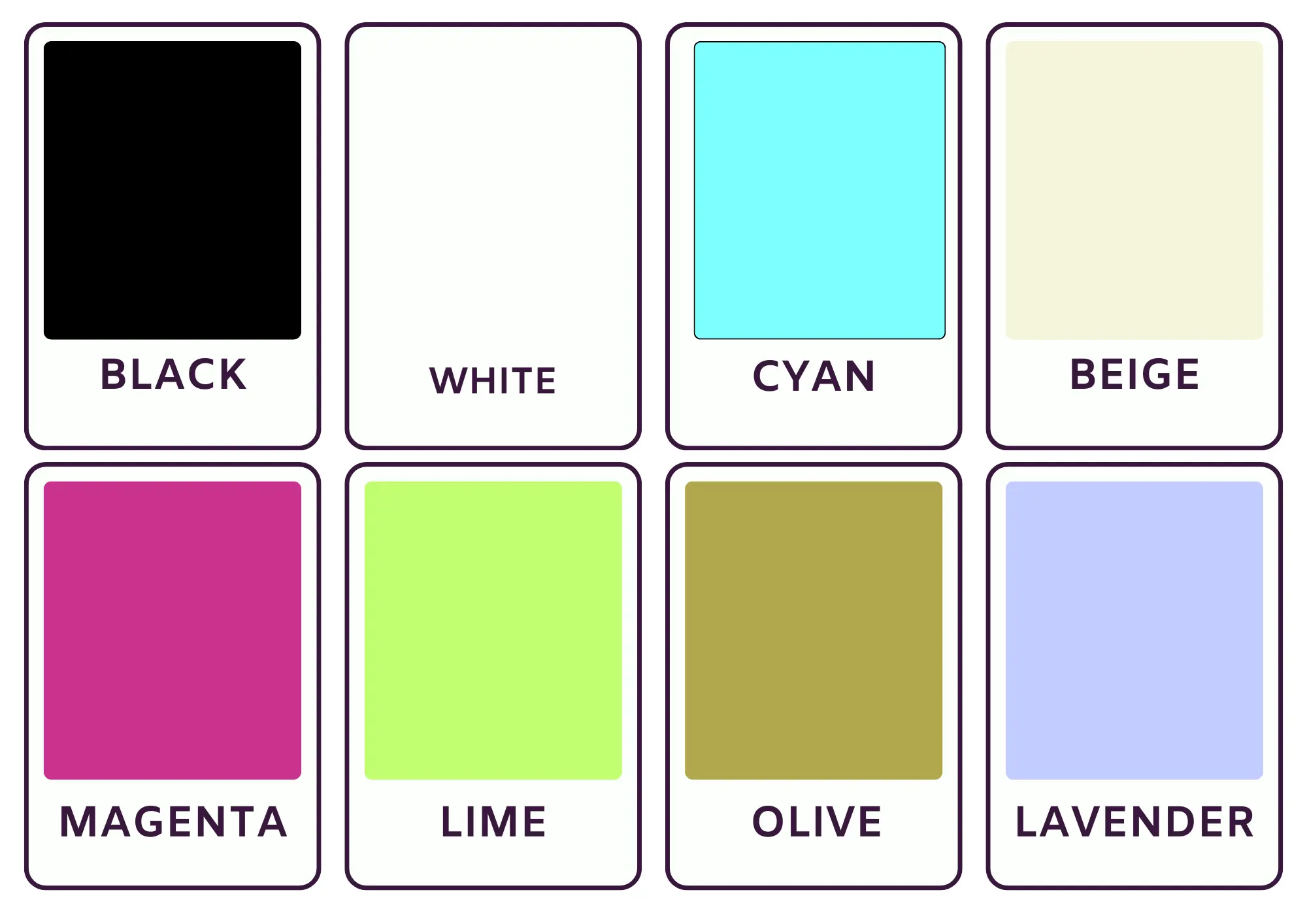1. Colour names in English
Below is a list of 100 colour names in English. I have included pictures and flashcards to help you memorise each of them more easily.

2. Characteristics
Colours are characterised by their hue, saturation, and brightness.
1. Hue is the actual colour itself (red, blue, green, etc.)
2. Saturation refers to the purity or intensity of the colour. A highly saturated colour is vivid and strong, while a less saturated colour is muted and dull.
3. Colour brightness describes how light or dark a colour appears
3. Meaning and perception by different cultures
Colour perception and symbolism vary greatly across different cultures.
Red1. Western cultures: Represents love, passion, energy, and danger (e.g., red hearts or warning signs).
2. China: symbolises luck, happiness, and prosperity, often used in weddings and celebrations.
3. India: associated with purity, fertility, and marriage; brides traditionally wear red.
4. South Africa: represents mourning and is often used at funerals.
5. Middle East: can symbolise danger, protection, or caution.
Blue1. Western Cultures: represents calm, trust, and stability; also associated with sadness ("feeling blue").
2. Middle East: seen as a protective colour against the "evil eye."
3. China and Korea: represents immortality and healing.
4. India: associated with Krishna, a deity symbolising divine love and compassion.
5. Latin America: often linked to religious devotion, particularly to the Virgin Mary.
Yellow1. Western Cultures: symbolises happiness, optimism, and energy, but also caution (e.g., yellow traffic lights).
2. China: represents royalty, power, and prosperity; historically reserved for emperors.
3. India: associated with learning, knowledge, and spring festivals like Holi.
4. Japan: represents courage and wealth.
5. Middle East: can symbolise mourning or loss in some regions.
Green1. Western cultures: symbolises nature, growth, and luck (e.g., four-leaf clovers), but can also mean envy or inexperience.
2. Islamic cultures: A sacred colour representing paradise and spirituality.
3. China: represents health and growth but can also have negative connotations (e.g., "wearing a green hat" implies infidelity).
4. Ireland: strongly linked to St. Patrick’s Day and Irish identity.
5. India: symbolises fertility and new beginnings.
White1. Western cultures: represents purity, innocence, and peace, often worn at weddings.
2. China and Japan: associated with mourning and funerals.
3. India: worn by widows, symbolising renunciation and spirituality.
4. Middle East: represents cleanliness and purity.
5. Africa: can symbolise purity and spirituality, depending on the region.
Black1. Western cultures: symbolises elegance and formality but also death, mourning, and mystery.
2. China: associated with water, darkness, and neutrality.
3. India: used to ward off evil spirits and bad luck.
4. Middle East: represents rebirth and mourning, often worn at funerals.
5. Africa: in some cultures, it can symbolise maturity and wisdom.
Purple1. Western cultures: historically linked to royalty, luxury, and power due to the rarity of purple dyes.
2. China: associated with divinity and immortality.
3. Japan: represents wealth and nobility.
4. Brazil and Thailand: associated with mourning and funerals.
5. India: represents creativity and spirituality.
Orange1. Western Cultures: represents energy, warmth, and enthusiasm.
2. India: a sacred colour symbolising purity and spirituality, often associated with Hindu monks.
3. The Netherlands: linked to the Dutch royal family and national pride.
4. Buddhist cultures: worn by monks, symbolising enlightenment and simplicity.
Pink1. Western cultures: associated with love, femininity, and romance.
2. Japan: represents spring, cherry blossoms, and youthfulness.
3. India: symbolises optimism and positive energy.
4. Korea: seen as a modern colour, symbolising trust and love.
Gray1. Western cultures: symbolise neutrality, balance, and formality.
2. China: often linked to modesty or mourning.
3. Japan: represents stability and maturity.
4. The science of colours
Light travels in waves. Each wave has a length. We call this a wavelength. Different wavelengths make different colours.
When light hits an object, the object absorbs some wavelengths and reflect the others. Our eyes receive the reflected wavelengths.
Our brain turns lights into colours that we can see.
4.1 What is a colour?
A colour is how our eyes and brain read a wavelength of light. The visible spectrum is the full range of light we can see. It goes from red, which has longer wavelengths, to violet, which has shorter wavelengths.
An object looks a certain way because it reflects some wavelengths and absorbs the rest. A red apple reflects more red light. A white shirt reflects almost all light. A black coat absorbs most light and reflects very little.
4.2 How do we see colour?
The retina is a thin, light-sensitive layer at the back of the eye. It holds special cells called cones. Cones work best in bright light and help us see detail and hue. We have three main types of cones. One type responds most to red light. One type responds most to green light. One type responds most to blue light.
When light enters the eye, each type of cone sends a small electrical signal. The brain mixes these signals and creates the wide range of colours we see. We also have rod cells. Rods help us see in dim light, but they do not detect colour well.
4.3 Colour blindness?
Colour vision deficiency means a person does not tell some hues apart in the usual way. The cone cells may be missing, fewer in number, or not working as expected. As a result, some shades look similar.
Most people with this condition still see many colours. It is not a disease you can catch. It is simply a different way the eyes and brain process light.
4.4 Types of colour blindness
There are several types of colour vision deficiency.
Red-green colour blindness is the most common type. People may find reds, greens, browns, and oranges hard to tell apart, especially in low light.
Blue-yellow colour blindness is less common. People may mix up blues with greens and may see yellows as pale or greyish.
Total colour blindness is called monochromacy. It is very rare. A person sees only shades of grey and often has light sensitivity.
4.5 What causes colour blindness?
Most cases are inherited. A gene is a set of instructions in our DNA. Some genes control how cone cells work. Changes in these genes can affect the cones in the retina. The genes for red and green vision sit on the X chromosome. Males have one X and one Y, so a single changed gene can cause the condition.
Females have two X chromosomes, so a healthy copy can often balance a changed one. Some cases are acquired. Eye diseases, damage to the retina, certain medicines, or ageing can also reduce colour vision. Special lenses help some people tell shades apart more easily, but they do not cure the condition.
5. Flashcards
I have made these flashcards to help you memorise colour names easily. Try to make simple sentences from them. For examples, you can discuss your likes and dislikes. Feel free to print them. I recommend printing them in landscape format.


